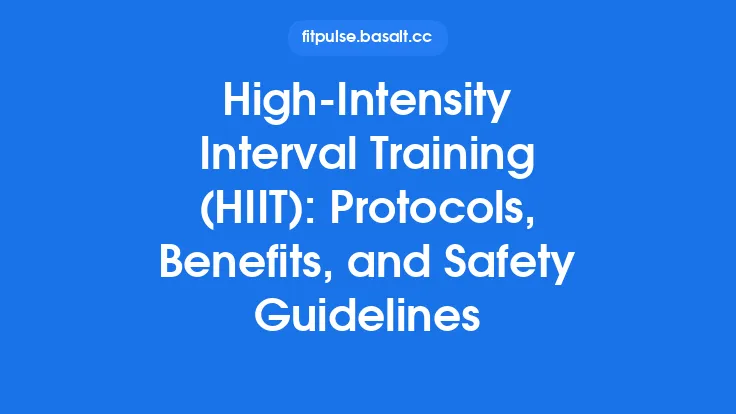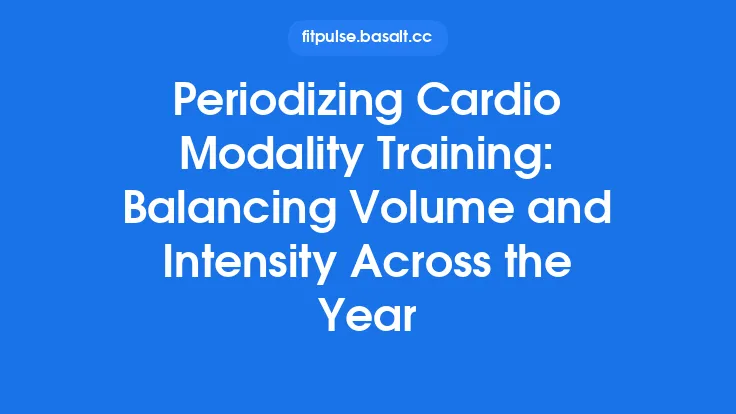VO₂ max, the maximal rate at which an individual can uptake, transport, and utilize oxygen during intense exercise, remains one of the most widely recognized markers of aerobic fitness. Because it integrates the performance of the heart, lungs, blood, and skeletal muscle, improvements in VO₂ max translate directly into enhanced endurance capacity, better health outcomes, and superior athletic performance. This article explores the physiological mechanisms that set the ceiling for VO₂ max and outlines evidence‑based training strategies that can systematically push that ceiling higher.
Physiological Foundations of VO₂ Max
The classic Fick equation describes VO₂ max as the product of two primary variables:
\[
\dot{V}O{2\ max}= Q \times (CaO{2} - CvO_{2})
\]
where Q is cardiac output (the volume of blood the heart pumps per minute) and (CaO₂ – CvO₂) represents the arteriovenous oxygen difference, i.e., the amount of oxygen extracted by the tissues. Any training program that seeks to raise VO₂ max must therefore target one or both of these components.
- Cardiac Output (Q) – Determined by heart rate (HR) and stroke volume (SV). At maximal effort, HR is largely genetically constrained, whereas SV can be significantly expanded through training.
- Arteriovenous O₂ Difference – Dependent on the capacity of the microvascular network to deliver oxygen to muscle fibers and the ability of those fibers to extract it. While the biochemical pathways of oxygen utilization are complex, the structural adaptations that increase extraction are largely vascular in nature.
Understanding these two pillars provides a roadmap for designing interventions that are both efficient and sustainable.
Central Determinants: Cardiac Output and Blood Transport
Stroke Volume Expansion
Repeated bouts of aerobic work stimulate several cardiac adaptations:
- Eccentric Hypertrophy – The ventricular walls thicken and the chamber enlarges, allowing a larger volume of blood to be ejected with each beat.
- Enhanced Myocardial Compliance – The heart relaxes more efficiently, filling more completely during diastole.
- Improved Frank‑Starling Mechanism – Greater end‑diastolic volume translates into stronger contractile force.
These changes are most pronounced after 6–12 weeks of consistent endurance training, with further refinements possible through periodized overload.
Blood Volume Augmentation
Endurance training also raises total plasma volume, which:
- Increases preload, further supporting stroke volume.
- Improves thermoregulatory capacity (though detailed thermoregulation is beyond this article’s scope).
- Dilutes hemoglobin concentration slightly, but the net effect is a higher absolute oxygen‑carrying capacity because of the larger plasma pool.
Techniques such as “hypervolemic training” (e.g., training in hot environments or with fluid loading) can accelerate plasma volume expansion, but they must be applied judiciously to avoid dehydration.
Peripheral Determinants: Capillary Network and Oxygen Extraction
Capillary Density and Distribution
Repeated aerobic stimulus promotes angiogenesis—the formation of new capillaries within skeletal muscle. The resulting increase in capillary‐to‐fiber ratio shortens diffusion distances, allowing more oxygen to reach mitochondria during high‑intensity work. This structural remodeling is driven by shear stress on the endothelial lining of existing vessels, a stimulus that is amplified by higher training intensities and volumes.
Hemoglobin Affinity and Red Blood Cell Turnover
While the oxygen‑binding affinity of hemoglobin is largely a fixed property, endurance training can modestly shift the oxyhemoglobin dissociation curve toward a rightward position, facilitating oxygen release at the tissue level. Moreover, regular training stimulates erythropoiesis, modestly raising red blood cell (RBC) count and thus the total oxygen‑transport capacity of the blood.
Training Modalities to Elevate VO₂ Max
A well‑designed program typically blends several training approaches, each targeting specific physiological levers. Below, each modality is examined in terms of its mechanistic impact and practical implementation.
Continuous Endurance Training
Description: Long, steady‑state sessions performed at 60–75 % of maximal heart rate (HRmax) for durations ranging from 30 minutes to several hours.
Mechanistic Impact:
- Sustained elevation of cardiac output promotes stroke volume adaptations.
- Prolonged shear stress encourages capillary growth.
- Increases plasma volume through chronic fluid shifts.
Programming Tips:
- Begin with 3–4 sessions per week, gradually extending duration by 5–10 % each week.
- Incorporate at least one “long run/cycle/row” each week that exceeds the typical training duration by 20–30 % to stimulate further cardiovascular remodeling.
Interval‑Based Approaches
While high‑intensity interval training (HIIT) is often discussed in the context of metabolic adaptations, interval work can also be harnessed specifically for VO₂ max enhancement without delving into metabolic minutiae.
Description: Repeated bouts of high‑intensity effort (85–95 % HRmax) interspersed with active recovery periods (40–50 % HRmax). Typical work intervals last 3–5 minutes, with recovery equal to or slightly shorter than the work interval.
Mechanistic Impact:
- Near‑maximal cardiac output during work intervals pushes the heart to adapt quickly.
- Elevated shear stress during high‑intensity phases accelerates capillary remodeling.
- Repeated exposure to high oxygen demand stimulates the arteriovenous O₂ difference.
Programming Tips:
- 2–3 interval sessions per week, each comprising 4–6 repetitions.
- Ensure a full warm‑up and cool‑down to protect against injury.
- Progress by increasing either the number of repetitions or the length of the work interval before adding more sessions.
Periodization and Progressive Overload
Concept: Systematically vary training volume and intensity over macro‑ (annual), meso‑ (monthly), and micro‑ (weekly) cycles to avoid plateaus and overtraining.
Implementation:
- Base Phase (8–12 weeks): Emphasize continuous endurance at moderate intensity to build foundational cardiac and vascular capacity.
- Build Phase (6–8 weeks): Introduce interval work and increase overall training volume by 10–15 %.
- Peak Phase (3–4 weeks): Focus on high‑intensity intervals with reduced volume to sharpen VO₂ max while allowing recovery.
- Taper (1–2 weeks): Decrease both volume and intensity by 30–50 % to consolidate gains and ensure peak performance.
Progressive overload can be applied by modestly increasing weekly training volume (5–10 %) or by adding a single high‑intensity interval each session, ensuring the stimulus remains novel.
Altitude and Hypoxic Strategies
Training in reduced‑oxygen environments (≈2,000–2,500 m above sea level) can stimulate erythropoietic responses that raise RBC mass, thereby expanding the blood’s oxygen‑carrying capacity.
Practical Options:
- Live‑High/Train‑Low (LHTL): Reside at altitude while performing high‑intensity sessions at sea level to preserve training intensity.
- Intermittent Hypoxic Exposure (IHE): Use hypoxic chambers or masks for 1–2 hours per day, several times per week, combined with normal training.
Cautions: Altitude exposure should be introduced gradually, and athletes should monitor for signs of excessive hypoxemia or impaired recovery.
Cross‑Training and Complementary Activities
Incorporating non‑running modalities (e.g., cycling, rowing, swimming) can provide a fresh stimulus to the cardiovascular system while reducing musculoskeletal overload.
- Benefits: Maintains high cardiac output without repetitive impact stress, promotes balanced muscular development, and can improve overall training adherence.
- Guidelines: Substitute one continuous session per week with a cross‑training activity of comparable duration and intensity.
Monitoring Progress and Adjusting the Program
VO₂ Max Testing
- Laboratory Test: Incremental treadmill or cycle ergometer protocol with indirect calorimetry provides the most accurate measurement.
- Field Test Alternatives: 5‑km time trial, 1.5‑mile run, or the Cooper 12‑minute run can estimate VO₂ max using validated equations.
Testing should be performed at baseline, after each mesocycle, and at the end of the training year to quantify adaptations.
Sub‑Maximal Markers
- Heart Rate at Fixed Sub‑Maximal Workloads: A decreasing HR for a given workload indicates improved cardiovascular efficiency.
- Recovery Heart Rate: Faster HR recovery post‑exercise reflects enhanced autonomic regulation and can be a proxy for VO₂ max improvements.
Training Load Quantification
- Session Rating of Perceived Exertion (sRPE): Multiply RPE (scale 1–10) by session duration (minutes) to obtain an arbitrary training load unit.
- Heart Rate Zones: Track time spent in zones 3–5 (moderate to high intensity) to ensure sufficient stimulus.
Adjustments are made when markers plateau for 2–3 consecutive weeks, indicating the need for a new overload stimulus or a recovery phase.
Practical Recommendations for Different Populations
| Population | Frequency | Session Focus | Key Adjustments |
|---|---|---|---|
| Recreational Adults | 3–4 × week | 2 continuous + 1 interval | Keep intervals ≤4 min; prioritize enjoyment |
| Competitive Endurance Athletes | 5–7 × week | 2–3 continuous, 2 interval, 1 recovery | Use periodization; incorporate altitude if feasible |
| Older Adults (≥60 yr) | 3 × week | 2 moderate continuous, 1 short interval | Emphasize safety, longer recovery, monitor HR |
| Youth Athletes | 4 × week | 2 skill‑specific, 1 continuous, 1 interval | Limit high‑intensity volume; focus on technique |
| Clinical Populations (e.g., cardiac rehab) | 3 × week | Low‑moderate continuous, occasional interval | Strict medical supervision; use sub‑maximal tests |
Common Pitfalls and How to Avoid Them
- Overemphasis on High‑Intensity Work
Risk: Diminished stroke volume adaptations due to insufficient volume.
Solution: Preserve a solid base of continuous training; limit high‑intensity sessions to ≤3 per week.
- Neglecting Recovery
Risk: Autonomic imbalance, increased injury risk, stalled VO₂ max gains.
Solution: Schedule at least one full rest day per week and incorporate active recovery (easy cycling, swimming).
- Inconsistent Training Load
Risk: Fluctuating stimulus leads to erratic adaptations.
Solution: Use a training log and weekly load calculations to maintain progressive overload.
- Ignoring Individual Variability
Risk: One‑size‑fits‑all programs may be too demanding or insufficient.
Solution: Tailor intensity zones based on personal HRmax or lactate threshold (while not focusing on lactate mechanics) and adjust based on observed responses.
- Improper Altitude Exposure
Risk: Excessive hypoxia can impair performance and health.
Solution: Limit altitude exposure to ≤2 weeks at a time and monitor blood oxygen saturation.
Future Directions and Emerging Tools
- Wearable Hemodynamics: Next‑generation chest straps and smart shirts can estimate stroke volume in real time, allowing athletes to fine‑tune training intensity based on central cardiac output rather than heart rate alone.
- Artificial Intelligence‑Driven Periodization: Machine‑learning algorithms that ingest training load, HR variability, and performance data can suggest individualized macro‑cycle structures to maximize VO₂ max gains.
- Portable Hypoxic Simulators: Compact normobaric hypoxia devices enable “live‑high/train‑low” protocols at home, expanding accessibility for non‑elite athletes.
- Genomic Insights: While genetics set a ceiling, emerging polygenic scores may help identify individuals who respond best to specific training modalities, allowing more precise prescription.
Bottom Line: Optimizing VO₂ max is a multifaceted endeavor that hinges on expanding cardiac output, enhancing the blood’s oxygen‑transport capacity, and improving the muscle’s ability to extract and utilize that oxygen. By integrating continuous endurance work, strategically placed high‑intensity intervals, periodized overload, and, where appropriate, altitude or cross‑training stimuli, athletes and active individuals can systematically push their VO₂ max higher. Consistent monitoring, individualized adjustments, and a balanced approach to stress and recovery are the keystones of sustained progress.





